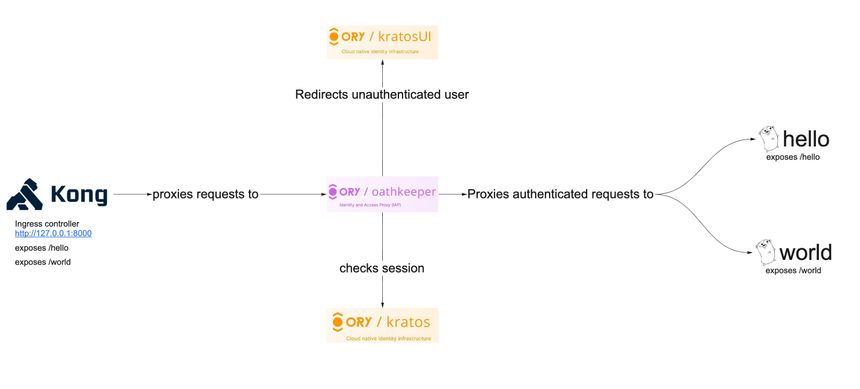Microservice architecture is nowadays almost a standard for backend development. An API gateway is an excellent way to connect a group of microservices to a single API accessible to users. API gateways are available from cloud providers such as AWS/Azure/Google Cloud Platform and Cloudflare. Kong is a scalable API gateway built on open source and as such can be an excellent alternative if you don't want to have your system locked in to a particular vendor.
This tutorial shows an example using Kong API gateway, Ory Kratos, and Ory Oathkeeper. The illustration below shows you the final architecture we are going to build in this guid
The full source code for this tutorial is available on GitHub.
What we will use
- Kong gateway can be an excellent solution for an ingress load balancer and API gateway if you do not want vendor lock-in of any cloud API Gateways in your application. Kong uses OpenResty and Lua. OpenResty extends Nginx with Lua scripting to use Nginx's event model for non-blocking I/O with HTTP clients and remote backends like PostgreSQL, Memcached, and Redis. OpenResty is not an Nginx fork, and Kong is not an Openresty fork. Kong uses OpenResty to enable API gateway features.
- Oathkeeper acts like an identity and access proxy for our microservices. It allows to proxy only authenticated requests to our microservices, and so we don't need to implement a middleware to check authentication. It can also transform requests, for example convert session auth into JWT for a back-end service.
- Kratos is the authentication provider; it handles all first-party authentication flows: username/password, forgot password, MFA/2FA, and more. It also provides OIDC/social login capabilities for example "Login with GitHub".
Building simple microservices
Let's say we have two microservices: hello and world. They are pretty simple
and serve only to test our API gateway, but you can switch them out for more
complex components.
The "World" microservice exposes a /world API endpoint and returns a simple
JSON message:
The "Hello" microservice exposes a /hello API endpoint and returns a simple
JSON message:
We now want to secure the access to these microservices and let only authenticated users access these endpoints.
Okay. Let's start hacking, shall we?
Ory Kratos setup
Follow the Quickstart guide to set up Ory Kratos. In this tutorial you only need a docker-compose file with the following configuration:
- HTTP
:4433and:4434are the public and admin API's of Ory Kratos. - HTTP
:4436for Mailslurper - a mock Email server. You can get an activation link by accessing http://127.0.0.1:4436. - HTTP
:4455for the UI interface that allows one to start sign-up/login/recovery flows.
After running docker-compose up you can open http://127.0.0.1:4455/welcome
to test your configuration.
Configuring Ory Oathkeeper
Now we can start configuring our gateways for this example. Kong is the entry point for the network traffic. Ory Oathkeeper would be accessible from the internal network only in this case. Let's review our architecture diagram from before:
Oathkeeper checks sessions and proxies traffic to our microservice while Kong provides ingress load balancing. We can even set up Round-Robin DNS to have a more robust configuration for our service. Here is how we configure the access rules for Ory Oathkeeper:
The Ory Oathkeeper configuration:
Ory Oathkeeper now looks up a valid session in the request cookies, and proxies
only authenticated requests. It redirects to login UI if there's no
ory_kratos_session cookie available.
Adding Kong
Now all that is needed is to configure Kong:
The docker-compose creates three containers
- db container with PostgreSQL database to store the configuration of services/routes for our API gateway.
- kong-migrate to run migrations against the database.
- kong container that exposes
8000port for proxying traffic and8001port with admin API.
As last step, we need to create a service for Kong and configure routes.
#!/bin/bash
# Creates an secure-api service
# and proxies network traffic to oathkeeper
curl -i -X POST \
--url http://localhost:8001/services/ \
--data 'name=secure-api' \
--data 'url=http://oathkeeper:4455'
# Creates routes for secure-api service
curl -i -X POST \
--url http://localhost:8001/services/secure-api/routes \
--data 'paths[]=/'\Testing
You can open http://127.0.0.1:8000/hello or http://127.0.0.1:8000/world in
your browser and there are two possible scenarios:
- You receive
{"message": "Hello microservice"}(or"World microservice"). - The browser redirects you to http://127.0.0.1:4455/login.
Further steps
- Configure
id_tokenmutator to have the identity accessible as JWT token for your microservices. - Configure the password policy to better suit your use case.
- Add two-factor authentication.
- Consider using authentication based on subrequest result instead of having an additional reverse proxy inside your network.
- Kong auth request can be an excellent plugin to use Ory Oathkeeper as a decision API for Kong.

